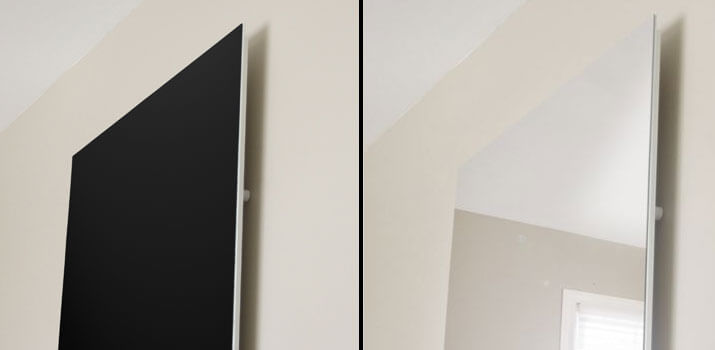What are the characteristics of an ideal heater? Technical principles and performance comparison
Share this page
Summary
- The main principles of residential heating: convection or radiant heating convection ou par rayonnement
- The expected characteristics of an ideal heater
- Comparison of different heating methods
- Summary table of different radiator technologies: pros and cons
The main principles of residential heating: convection or radiation?
No matter which heat emission technology is used (electric or hot water heating), there are 3 heat emission modes for heating:
- the conduction heating (eg: low temperature floor heating. Feet are in contact with the floor)
- the convection heating (hence the name convectors)
- the radiant heating (hence the name radiators = radiant / radiation wrongly used to any existing heater)
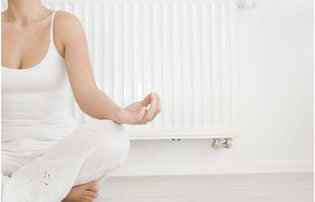
Thermal comfort and low consumption
A convection heating heats the air directly. The cold air heats up on contact with the heat emitter (grid, plate, resistance), and then rises to the ceiling while getting warm. Then it gradually cools down because of the heat loss of the room. This creates an air flow (stirring dust burned in contact of the emitter) and a cycle of cooling and heating.
The radiant heating do not heat the air directly, it heats the mass surfaces (floor, walls, ceiling, objects) that absorb and return the heat to the ambient air of the room. Unlike the convectors with which the hot air is stratified (floor at 15°C, mid-height at 19°C, ceiling at 25°C), with radiant radiators the air temperature is almost homogeneous from floor to ceiling. This distinction is critical since the air is not stirred (with allergens and dust) and the experienced thermal comfort is significantly higher (comparable to the sun), therefore you avoid increasing the temperature of the thermostat (and the consumption).
>> The choice of radiant heating is not being discussed anymore these days: it is the heating technology that we should be looking for!
What are the expected characteristics of an ideal heater?
This article takes interest in the efficiency of different heat emitters and not in the comparison of various heating technologies (heat pumps, wood/pellet stove, etc.).
Do not lose sight that the radiator is not everything! The 3 golden rules to optimise the bill and comfort are:
- An effective insulation of the walls, floor, ceiling and windows. A good airtightness.
- A good orientation of the rooms to benefit from the external energy inputs.
- An efficient radiator which means:
- one that emits as much radiation as possible (and therefore the less convection possible). Today no legislation imposes a minimum radiation rate to be able to “use” the name of a radiant heater/radiator. A radiator emitting at least 50% of radiation is the minimum you should be looking for. Note, radiant heaters for less than 500€ do not exceed 40% of radiation rate. Among the best brands of radiant radiators on the market: DEGXEL, CAMPA, CINIER, HEAT4ALL, etc.
- one with a large heat-emitting surface according to its power.
- one with little inertia (by its design) and associated with a high performance thermal regulation.The radiator with little inertia (thin, no cast heat emitter) associated with a high performance thermostat will deliver heat rapidly to the room avoiding heat waves. Indeed, the more inertia the heater has, the longer it will take to load the energy and thus to restore it. Besides, when the outside temperature rises during the day due to solar heat, the heater keeps providing the stored energy even if it exceeds the set desired temperature and thus creates heat waves and unnecessary consumption. To respond with flexibility to any changes of settings (comfort, eco, absence, anti-freeze), theheater must be responsive.
- one with the right power. Ask the manufacturer or installer for a power balance. An electrician uses mostly 100W per m2 for electric heating (1000W for a room of 10 m2). For the most efficient electric radiant radiators (infrared), 60W per m2 are sufficient. There is no need to oversize when we know the thermal parameters of the room (surface, height, insulation, orientation, desired temperature) and can deduce the heat losses and the required power of the heater.
- one that is well placed in the room. Radiant radiators are especially effective when well placed so that the radiation can reach all areas of the room (floor, wall, ceiling). Do not place the heater behind any furniture that would block the radiation. Only high performance radiators can radiate up to 3-4 meters of distance in order to reach all the areas of the room.
Comparison of different heating modes, advantages and disadvantages…
Can not decide between different technologies of radiators? This article is made for you.
Convectors are the basic version that has popularised the electric heating in the 80s. Technologically, it has changed little. Expect a power need (therefore consumption) which ranges from 100 to 150 Watts per m2! They only work on the principle of convection by heating the ambient air that stratifies in the room (15°C at the floor level, 27°C under the ceiling). Most often it dries the air and creates heat waves (hot air current) sometimes experienced as unpleasant. This outdated technology is to be removed.
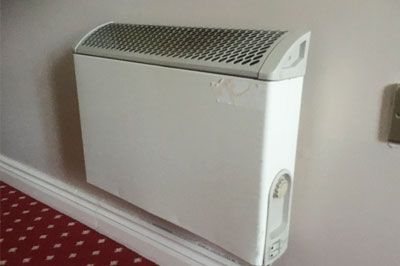
Electric convector
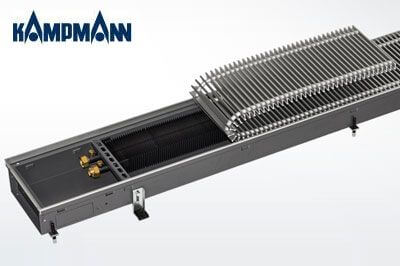
Trench Heaters
Electric baseboard heaters operate on the principle of convectors. Their length helps mitigate the convection effect with a good heat distribution in the room. They heat cold air immediately at ground level. It costs around €300 € per meter. Trench heater (or floor fan coil) is a variation of an electric baseboard heating for even more space saving.
Le radiateur à inertie est composé d’un corps de chauffe en céramique, en fonte, en stéatite, en verre, en brique, ou en pierre. Ce dernier a des propriétés d’accumulation thermique importantes via une résistance électrique située en son cœur (radiateur à inertie sèche) ou grâce à un fluide caloporteur qui le parcoure (radiateur dit à inertie fluide). L’énergie est ensuite transmise à la carcasse du radiateur (à forte émissivité – aluminium) qui émet lentement par rayonnement basse température et par convection, même lorsque le radiateur n’est plus alimenté électriquement. Le concept est séduisant.
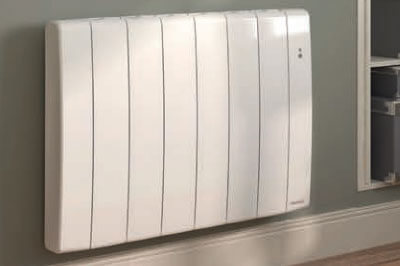
Dry or fluid inertia heater – Photo credit Thermor
The inertia heater is composed of a ceramic, cast iron, soapstone, glass, brick, or stone heating body. The latter has important thermal storage characteristics via an electric resistor located in its core (dry inertia heater) or through a coolant which passes through the heater (fluid inertia heater). Th energy is then transmitted to the heater’s shell (high emissivity – aluminium) which slowly emits heat by radiation at low temperature and by convection, even when the heater is no longer electrically powered. The concept is attractive.
We speak of “gentle heat” (often wrongly) only if the heater has the ability to radiate the heat accumulated in the form of infrared (like the sun). Fluid inertia heaters give us a better feeling of gentle heat (than dry inertia heaters) due to a more uniform surface temperature and a better thermal efficiency. The main problem is the lack of responsiveness of the heater (due to its inertia) to stick strictly to the selected temperatures in order to avoid overconsumption and heat waves. The integrated regulation of the heater must be very efficient to “master” the inertia.
Hot water heaters connected to the central heating (gas boiler, wood, fuel oil, etc.) typically offer a good thermal comfort if they are low temperature.
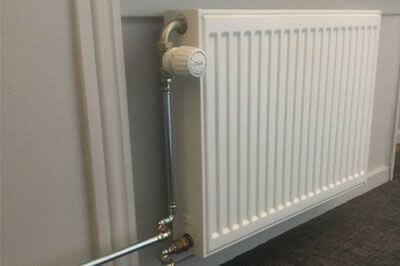
Water loop heater central heating
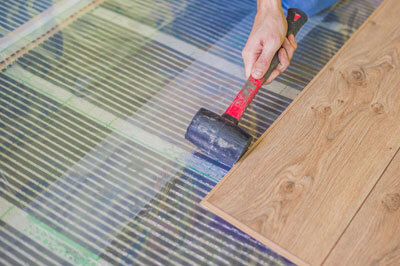
Radiant floor heating (hydraulic or electric)
The floor heating (hydraulic low temperature or radiant electric) is an investment that must be carefully considered. Indeed, except fully renovating the floor, it is not replaceable as a heater. It has the advantage of good heat distribution (no cold area) throughout the room and a great comfort. However, its inertia can cause overconsumption and discomfort on midrange models. The radiant hydraulic floor has the advantage to help cooling in summer (cold water circulation).
The radiant heaters with a frontal perforated grid emit the heat by radiation (between 10% and 30%) and by convection. The range of the radiation is 1 meter. Only close surfaces will be heated by the radiation, the remaining volume will be heated as a convector. There are radiant panels of first generation (so-called opened) of which the heat emitter is visible through the perforated grid and enclosed panels (so-called heating panels). Enclosed panels are more efficient from a comfort and energy point of view. Most of the time these are infrared radiators (see below).
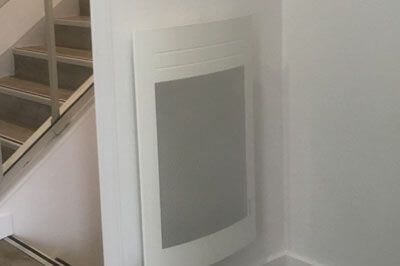
Simple radiant heater with frontal grid
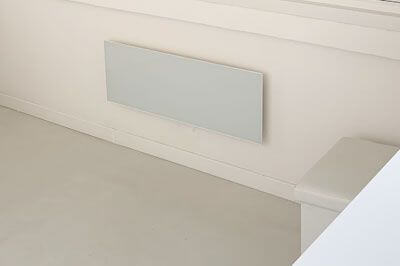
High performance electric far infrared radiators – Picture Credit HeatGood.com
High performance infrared heaters are radiant radiators which radiation performance is > 50% (thus 50% of convection only). These are the heaters which are the closest to the notion of ideal radiators because they meet all required characteristics (see above) to optimise comfort and low consumption: enclosed panel, uniform surface temperature over the whole panel, low inertia, electronic control of your choice as they are not onboard (hence the possibility to choose a performant control system), high radiant component (so gentle heat), large panel surface.
Warning! The lack of regulation on the infrared radiators should lead buyers to be especially vigilant. Indeed, we can find in this category extremely performant radiators as well as simple radiators operating mainly as convectors. The prices vary from 100€ to over 1500€ for the same power. To know more about the infrared radiator.
Summary table of different radiator technologies
The thermal efficiency of a radiator corresponds to the capacity of the heat emitter to produce a homogeneous heat in the space (from floor to ceiling), constant over time and comfortable (no heat waves and no drying air). Therefore its electronic control must efficiently take into account the outside temperature variations (and solar gain) and the variable presence of the occupiers (setpoint changes (eco, comfort)). It is therefore the couple radiator – regulation that defines the aptitude of a radiator to its function (its aptitude coefficient).
| Technology |
Advantages | Disadvantages |
|---|---|---|
| Electric Convector |
– | THE – :
|
Electric Baseboard Heaters |
THE + :
|
THE – :
|
Trench Heaters
|
THE + :
|
THE – :
|
+++ Inertia Heaters (dry or fluid)
|
THE + for the best models:
|
THE – :
|
+++ Hot Water Heaters (central heating)
|
THE + for the best models:
|
THE – :
|
Underfloor Heating
|
THE + :
|
THE – :
|
Electric Radiant Radiator
|
THE + :
|
THE – :
|
+++ Far Infrared Radiator
|
THE + for the best models:
|
THE – :
|
Sources: Foxof Consultancy – Appellations according to European standard CEI 675
Conclusion: to date, we believe the best heaters (high-end models) are the fluid inertia heaters and the electric far infrared radiators. Note that from a thermal (comfort and consumption) point of view it is always more efficient to increase the number of hot spots (radiators) in the room. For instance, when in need of 2100W you should prefer 3 rheaters of 700W rather than 2 of 1000W. This is a constant whatever the technology of the radiator is.
Other topics that may interest you
To know more about the infrared heating for housing
To know more about the different heating technologies for housing
FOX44








